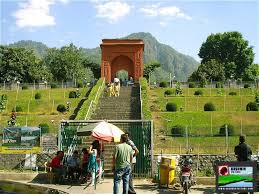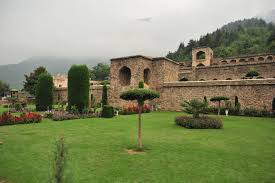|
Main Attractions: Dal
Lake, Nagin Lake, Mughal Gardens, The Islands, The Bund, Sri
Pratap Singh Museum, Nasim Bagh, Pari Mahal, Hari Parbat Fort,
Burzahom
Dal L ake ake
The Dal is famous not only for its beauty, but for its vibrance,
because it sustains within its periphery, a life that is unique
anywhere in the world. The houseboat and Shikara communities
have lived for centuries on the Dal, and so complete is their
infrastructure on the lake, that they never have to step on
land! Doctors, tailors, bakers- one can see them all in tiny
wooden shops on the lake, near picturesque vegetable gardens and
acres of lotus gardens.
Nagin Lake
Nagin Lake, which is usually thought of as a separate lake, is
also divided from Dal Lake only by a causeway. The causeways are
mostly suitable for walkers and bicycles only so they make a
very pleasant way of seeing the lake without having to worry
about traffic or Shikaras. The main causeway across the lake
carries the water pipeline for Srinagar's mains water supply.
Mughal Gardens
Kashmir was a favourite of th e
Mughal emperors who visited it as often as they could. Cool and
refreshing after the plains of North India where the business of
governance kept them, they planted gardens with stepped terraces
and flowing watercourses. When they rested in their gardens,
they dreamt they were in paradise. e
Mughal emperors who visited it as often as they could. Cool and
refreshing after the plains of North India where the business of
governance kept them, they planted gardens with stepped terraces
and flowing watercourses. When they rested in their gardens,
they dreamt they were in paradise.
Cheshma Shahi is the first Mughal garden one will pass after
Nehru Park. Built at a height above the city, its views are as
stupendous as its layout. The smallest of Srinagar's Mughal
gardens, Cheshma Shahi has only three terraces in addition to a
natural spring of water enclosed in a stone pavilion.
The next garden along the road that encircles the Dal is the
Nishat, built by empress Nur Jahan's brother Asaf Khan. The
largest of the gardens, Nishat has several terraces, a central
watercourse and a majestic site between the Dal and the Zabarwan
hills.
The third Mughal garden - the Shalimar - was planted by Jehangir,
the Mughal emperor, whose love for Kashmir was legendary. Shaded
by magnificent Chinar trees, the Shalimar is a series of stone
pavilions and flowing water with paint box bright flowerbeds.
Nasim Bagh
Only a short distance beyond the Hazratbal mosque, the Nasim
gardens, the 'garden of tepid airs' or 'garden of the morning
breeze', were built by the Mughal emperor Akbar after his
conquest of Kashmir in 1586. He had 1,200 Chinar trees planted
in the garden, which is the oldest of Kashmir's Mughal gardens.
Pari Mahal
The old Sufi colleg e
of Pari Mahal, the 'palace of the fairies', is only a short
distance above the Chasma Shahi gardens. One can easily walk
from the gardens up to the Pari Mahal then follow a footpath
directly down the hill to the road that runs by the Oberoi
Palace Hotel. The Pari Mahal consists of a series of arched
terraces. Recently it has been turned into a very pleasant and
well-kept garden with fine views over Dal Lake. It's
attractively sited on a spur of the Zabarwan Mountains. The
gardens are beautifully kept even today and a Son Et Lumiere
show is put on here every evening during the May to October
tourist season. e
of Pari Mahal, the 'palace of the fairies', is only a short
distance above the Chasma Shahi gardens. One can easily walk
from the gardens up to the Pari Mahal then follow a footpath
directly down the hill to the road that runs by the Oberoi
Palace Hotel. The Pari Mahal consists of a series of arched
terraces. Recently it has been turned into a very pleasant and
well-kept garden with fine views over Dal Lake. It's
attractively sited on a spur of the Zabarwan Mountains. The
gardens are beautifully kept even today and a Son Et Lumiere
show is put on here every evening during the May to October
tourist season.
Islands
There are three main islands in the lake, each poplar excursion
points. Silver Island is at the northern end of Dal Lake and is
also known as "Char Chinar" after the four-chinar trees, which
grow on it. There's a small snack bar on the island as there is
also on Gold Island at the south end of the lake. It is also
known as "Char Chinar" for it too has four Chinar trees.
The third island is Nehru Park, at the end of the main stretch
of the boulevard and only a short distance from the shore. It
too has a restaurant although it's a very run down, miserable
affair. The children's playground here has also seen better
days. Often in summer there are evening shows, dances and
festivals held at Nehru Park.
North of Nehru Island a long causeway leads out into the lake
from the boulevard just off its end is "Kotar Khana", the 'house
of pigeons', which was once a royal summer house.
The Bund
From above Zero Bridge to below Badshah Bridge one can walk
along the banks of the Jhelum River on the popular footpath
known as the bund. It's a pleasant relaxing place to stroll
along and many Doonga houseboats can be seen beside it. The GPO,
the government handicrafts emporium and a string of handicraft
shops are all close beside the Bund.
Shri Pratap Singh Museum
The Shri Pratap Singh museum is in Lal Mandi, just south of the
river between zero bridge and Amira Kadal. It has an interesting
collection of exhibits relevant to Kashmir including illustrated
tiles excavated near Harwan.
The museum is open from 10.00 am to 5.00 pm except on Wednesdays
when it is closed and admission is free.
Hari Parbat Fort
The 18th century fort tops the Sharika Hill, which is clearly
visible, rising to the west of Dal Lake. The fort was
constructed by Atta Mohammed Khan from 1776 but the surrounding
wall is much older, it was built between 1592 and 1598 during
the rule of Akbar. The wall stretches for 5-km and is 10 metres
high and has two gates, the Kathi and Sangin Darwaza.
Burzahom
In the opposite direction from the Shalimar gardens about 5-km
to the northwest, are the even older excavations of Burzahom.
The archaeological dig here has provided evidence of people
living in the vale up to 5,000 years ago. The oldest excavations
have revealed implements, pots, animal skeletons, arrowheads and
tools from the Neolithic age. Much of the material taken from
this site is now in the museum in Srinagar.
|